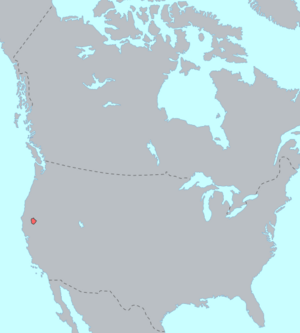Yana language facts for kids
Quick facts for kids Yana |
|
|---|---|
| Native to | USA |
| Region | California |
| Ethnicity | Yana |
| Extinct | 1916, with the death of Ishi |
| Language family |
Language isolate or Hokan?
|
| Dialects |
Yahi
|
| Linguist List | ynn |

Pre-contact distribution of the Yana language
|
|
The Yana language was once spoken by the Yana people. They lived in north-central California, between the Feather and Pit rivers. This area is now part of Shasta and Tehama counties in the USA.
The last known speaker of the Yahi dialect was Ishi, who passed away in 1916. The Yahi dialect was the southernmost version of Yana. We don't know exactly when the last speakers of the other Yana dialects died. Much of what we know about Yana comes from the work of a linguist named Edward Sapir.
The names Yana and Yahi come from the word ya, which means "people." Then a special ending is added: -na for the northern dialects and -hi or -xi for the southern ones.
Where Yana Was Spoken
The Yana language had four main versions, called dialects. These were:
- Northern Yana
- Central Yana
- Southern Yana
- Yahi
Edward Sapir studied Northern Yana, Central Yana, and Yahi very well. He worked with speakers like Betty Brown, Sam Batwi, and Ishi. We have only a few words and phrases from Southern Yana. This makes it hard to know if there were even more smaller dialects.
Northern and Central Yana were quite similar. They mostly had small differences in how words sounded. Southern Yana and Yahi were also very close to each other. However, the northern and southern groups were quite different. Speakers from one group would find it hard to understand the other.
Yana Language Family
Many experts group Yana with other languages in a larger family called Hokan. Edward Sapir thought Yana was part of a "Northern Hokan" group. This group included languages like Karuk and Chimariko.
Today, many linguists think Yana is a language isolate. This means it's a language that doesn't seem to be related to any other known language family. It stands alone. Yana has a special way of forming verbs that is not common in Hokan languages. This suggests Yana has been in the same area for a very long time.
How Yana Works
The Yana language used 22 different consonant sounds and 5 vowel sounds. It is a polysynthetic language, which means words can be very long. They combine many parts to express a full idea. It is also agglutinative, meaning words are built by adding small pieces (like LEGO bricks) to a main part.
In Yana sentences, the usual order of words is subject-verb-object. This is like saying "The boy eats the apple." Verbs in Yana carry a lot of meaning. They change by adding different endings or beginnings (called affixes). For example, verbs that show movement must include a special part that tells you the direction.
One unique thing about Yana is that men and women used slightly different forms of words. This is not common in many languages around the world.
Linguists have collected many stories and texts in Yana. These stories often focus on direction and location. They also use a lot of repetition. This was a traditional way of telling stories. Yana stories also assumed the listeners knew a lot about the characters and events. This is because the Yana people lived in small communities. Stories were told again and again, so everyone knew them well.
See also
 In Spanish: Idioma yana para niños
In Spanish: Idioma yana para niños

